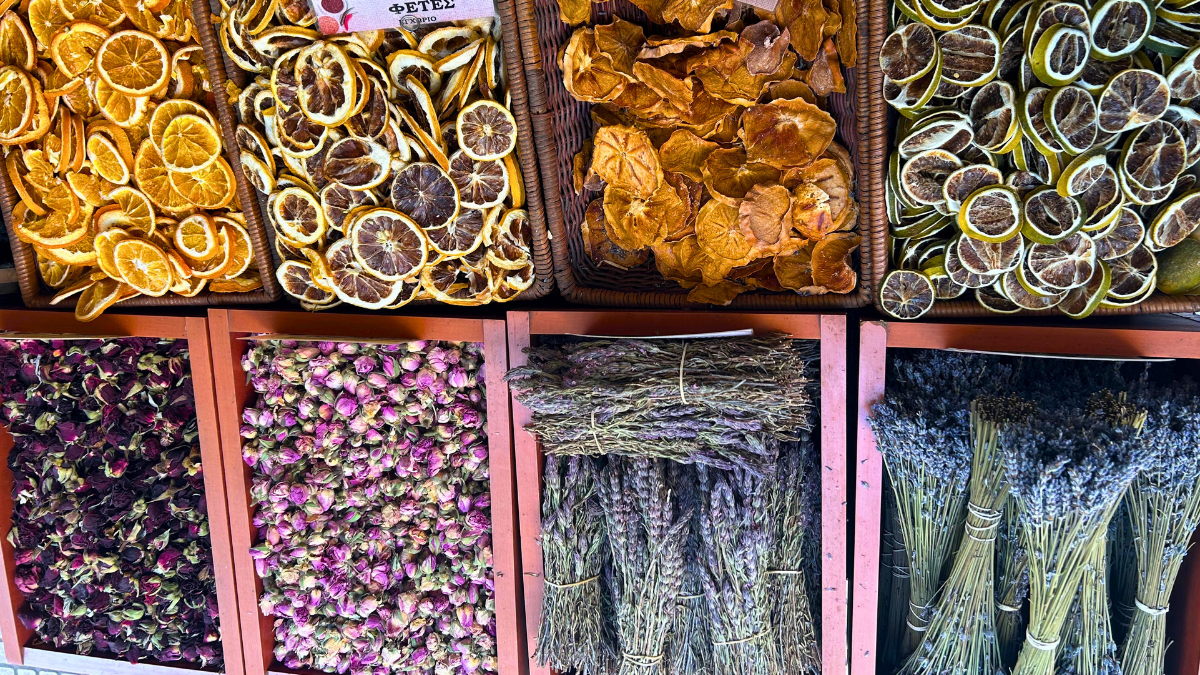
Our tour guide, Julia Pantakis, leads us like willing sheep through the maelstrom that is tourism at the very heart of foodie Athens – the Central Market and surrounding spice shops and delis.
We trail, mouths open, mobiles at the ready, dodging tourists and traffic, keen to catch every moment.
It’s early summer but the sun already feels fierce early in the morning. That doesn’t stop us starting the tour with warm custardy bougatsa, pastries showered with soft sugar, and served with hot Greek coffee (ask for sketo if you don’t want any sugar).
We’ve been watching a young pastry chef at Crème Royale roll, flatten, brush with butter then casually whirl around a pastry sheet until it’s vast and as fine as tissue paper to make filo pastry.
It’s filled with semolina custard, then baked until crispy. Bougatsa is often eaten for breakfast and, frankly, it makes toast seem pretty boring.
History is everywhere
Julia shows us the handsome 1840s building where she grew up, just across from the market in Psirri, amid spice shops and delis.
Her grandfather was a butcher at the market for 58 years. This is definitely her territory.

Creamy and crispy bougatsa – is there a better way to start the day?
Next stop is Athens’ oldest spice shop, Fotsi, started in 1930 and still in the same family.
There’s a heady smell of herbs and spices, ropes of dried fruit and vegetables, bundles of cinnamon quills, boxes of dried lemon, orange and lime slices (popular for cocktails apparently), dried rosebuds, plus myriad jars and baskets of spices and herbs.
For all this variety, one herb is king – oregano. It‘s the most popular and the most used herb. ‘‘But you can’t use it fresh’’, Julia advises. ‘‘It’s too bitter.’’
Tea of the gods

We’re in good hands with our guide, Julia.
We sample mountain tea, made with leaves sourced from sacred Mount Olympus, a herbal brew used by the ancient Greeks and said to be good for the memory, and as a digestive and anti-inflammatory.
We see ‘tear drops’ of mastic, the sticky resin that comes only from the island of Chios, and is used in ice cream and cooking and sometimes for medicinal purposes. At $360 a kilo it’s a costly ingredient.
Close by, at an Armenian deli opened in the 1930s, we sample slivers of pastirma, air-dried and pressed beef with a spicy paprika, pepper cumin, salt crust. We also try dolmades, fresh vine leaves stuffed with rice, lemon and dill but, everyone agrees, more delicious than any we have ever eaten.
‘‘The secret is that the vine leaves are really fresh.’’
Then it’s off for a master class in olives – big and small, in oil, in brine, in herbs, in chilli.

A visit to a spice shop is a feast for all the senses. Photo: Author supplied
We hear that green olives are picked early and the later olives are picked the darker they are.
Black are almost the last. Those crinkly black olives you can buy are left on the tree until they start to shrivel.
A young couple from California are surprised at the idea of eating just olives. ‘We have them on pizza’, and the stuffed olives ‘are right for cocktails – that’s how we use them’.
‘‘One way to serve olives is with halva (made from sesame seed, sugar and water) – so you have something sweet and something savoury’’, says Julia. ‘‘But Greek people really just enjoy a bowl of olives and a glass of wine.’’
Seeing seafood and nose-to-tail tradition
We know Greece’s wine-dark sea is a plentiful source of seafood, but the market still surprises.
It is a mass of squid, octopus, cuttlefish, loads of sardines, anchovies, grouper, tuna, prawns, mackerel and so much more – glistening, slippery and boat-fresh.
The squeamish among us are happy to move quickly through the meat section. Nose-to-tail eating is traditional in Greece, and stomach, brains, kidneys, tongue and testicles are all on display.
Retsina and the flavour of Greece
Our next pit stop is a small bar where we savour bites or meze of grilled vegetables and meat, traditionally served with the Greek wine, retsina.
Retsina has been made for more than 2000 years.
Pine resin was used to seal the ancient amphorae and later wine barrels were made of pine. That resin flavour permeated the wine and, as people liked it, it became part of the process.

Lunch comes with a view, including a glimpse of the Parthenon.
Retsina does have a bad reputation (as the source of hangovers). But it also has an aroma of pine, which is a wonderful fragrance you pick up especially in the Greek countryside, so it’s very evocative (the secret is not to drink too much – nothing new there).
Finally, at Oyzepi, an old-school taverna where we can glimpse the Parthenon from the window, we’re treated to a feast, notably gemista, tomatoes (‘the summer queen’ says Julia’s son Douk) stuffed with rice, spices, fresh herbs and loads of oil, then slow roasted.
We try regional cheeses, including graviera, a sheep and cow’s milk cheese from Crete, often served as a dessert with honey and cinnamon (try it – it’s fantastic).
Then we finish with a shot of raki, a fiery grape-based spirit – and a toast to summer in Athens.
Margaret Barca was a guest of Delicious Athens, which runs food and cooking tours in Athens.
